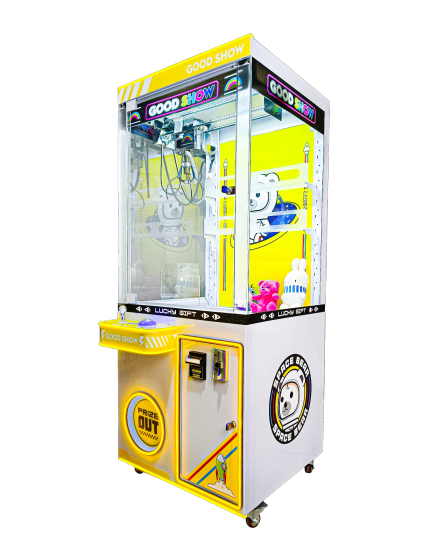While owning a claw machine can be lucrative, the level of profitability relies on factors such as location, cost control, and marketing methods. In high-traffic places like shopping malls or entertainment venues, a claw machine can earn from 5000 to 10000 RMB every month; net monthly profits are around 2000–3000 RMB after deduction of rent, maintenance, and other costs. Operators can increase revenue by changing prizes frequently, using limited-time promotions, and attracting more customers via social media. In addition, you need to ensure that the prizes are appealing by selecting ones with high value and optimizing cost control.
Table of Contents
ToggleLocation Affects Profitability
Claw machine profitability is largely tied to location. Claw machines in shopping malls, cinemas, amusement parks, or airports tend to generate significant earnings due to high foot traffic in these places. Consumers who shop or spend time in such locations are often willing to spend a few yuan for a chance at winning prizes.
Based on empirical data, claw machines placed at shopping mall entrances have much higher income than those in regular retail areas, with sales increasing by 30–50% on weekends and holidays. The positioning of the claw machine is also crucial; machines placed in high-traffic areas or near rest zones are seen more often and used more frequently, inevitably increasing profits.
Conversely, if operators place claw machines in low-traffic areas such as office buildings or residential zones, even though rental may be cheaper, the lack of entertainment demand from customers lowers revenue. Therefore, the quality of the location directly determines the profits that claw machines can generate.
Equipment and Operating Costs
Claw machine profitability is also affected by equipment and operating costs. The initial cost of a claw machine ranges between 3000–10000 RMB, and prices vary depending on the machine. Initial costs include registration and training, but there are also daily operating costs, including maintenance, rent, and electricity. Rent is generally the second-largest monthly commitment, accounting for 30%–50% of total operating costs in some cases, such as malls or busy streets, and it is often variable (based on a percentage of sales), influencing profitability.
The main thing that operators have to keep in mind is that revenue generated should be sufficient to meet operational expenses. For instance, if a claw machine attracts 50 users per day, with each game costing 5 RMB, the revenue would be 250 RMB per day. The monthly income is estimated at 5000 RMB after deducting rent, electricity, and maintenance costs. Making a profit would be questionable if daily usage falls below this criterion. As a result, usage is very important to the profitability of a claw machine.

Prize Types Directly Affect Consumer Engagement
One of the things that attract people to play claw machines is the prizes. Prizes such as stuffed toys or key chains, especially at the lower cost end of the scale, are less desirable among consumers compared to more exclusive items like stylish or limited-edition prizes (e.g., collaborative toys, popular anime merchandise). Appealing to a younger consumer demographic can encourage repeat play.
Some operators also swap out prizes for higher-value electronics or other trendy rewards to attract more customers. For example, during holiday times, offering special dolls or popular toys can increase sales. Data shows that machines offering limited-edition prizes can see a sales increase of up to 40% compared to normal days. This indicates that the choice and refreshment of prizes influence whether people play again, which essentially affects how much a particular claw machine makes overall.
Marketing Strategies to Boost Revenue
Operators who run claw machines rely not only on location and equipment but also on marketing strategies to make the machine more profitable. Social media and offline events are employed by many operators to advertise their machines and attract more customers. For instance, by posting videos of winners on social platforms or providing limited-time discounts, claw machines gain further exposure and engagement.
Others attract more target customers through holiday promotions by providing raffle events with customized prizes during special days like Children’s Day or Valentine’s Day. One chain even shared its operational data: claw machine usage during special promotion seasons saw an uptick of 25%, resulting in a tangible uplift in revenue.
Operators also apply membership systems or points redemption to increase customer loyalty, attracting customers for repeated visits that will result in more profits.
Market Demand and Consumer Trends
The profitability of claw machines is closely tied to market demand and consumer preferences. Over the last few years, claw machines have become particularly popular among young people born in the 1990s and early 2000s. Claw machines are typically used by individuals between the ages of 16 and 35, meaning they have become more of a social interaction than simply a means of winning prizes.
In addition, claw machines are part of the “check-in culture,” as numerous customers enjoy sharing on social media about what they have won. This has fueled demand for claw machines, especially at malls and tourist attractions, as they provide a social outlet for young people.
Recently, mini claw machines have emerged. These are small and less expensive, which could be ideal for placement in tight, high-volume commercial spaces. The prizes in mini claw machines often include small gifts such as accessories, stationery, or snacks, which are relatively cheap and can easily attract consumers. They enjoy relatively high profit margins because of the lower costs.








